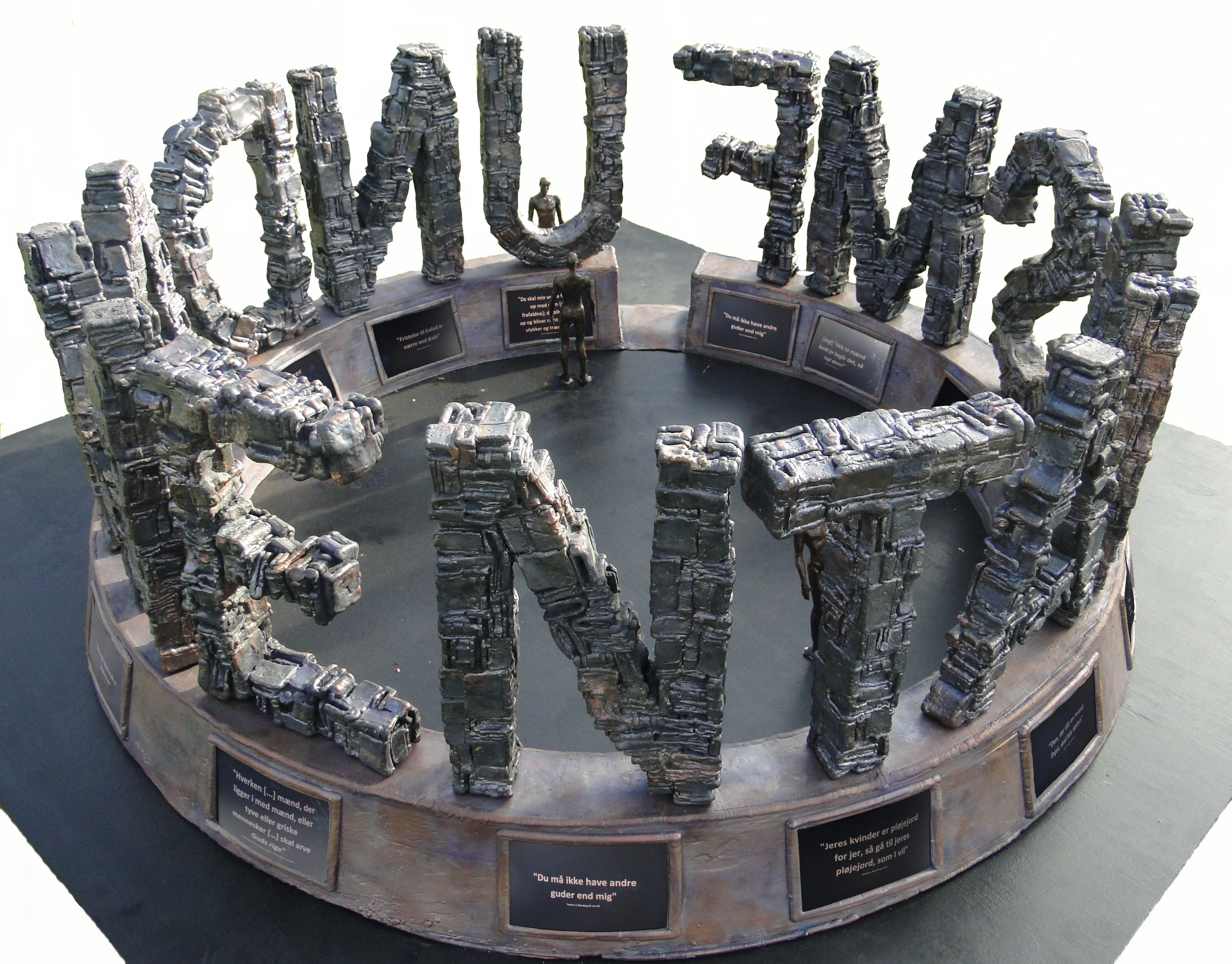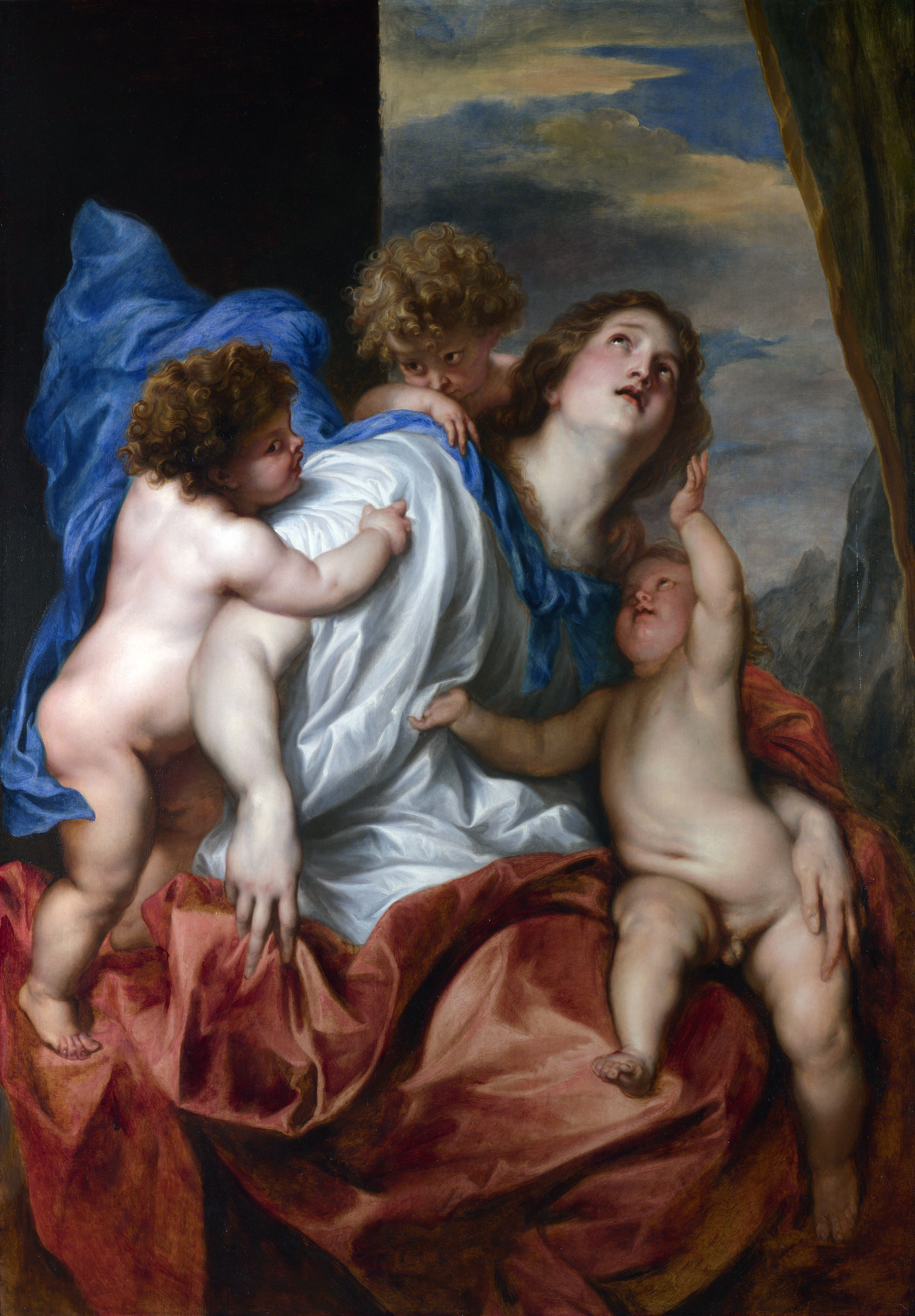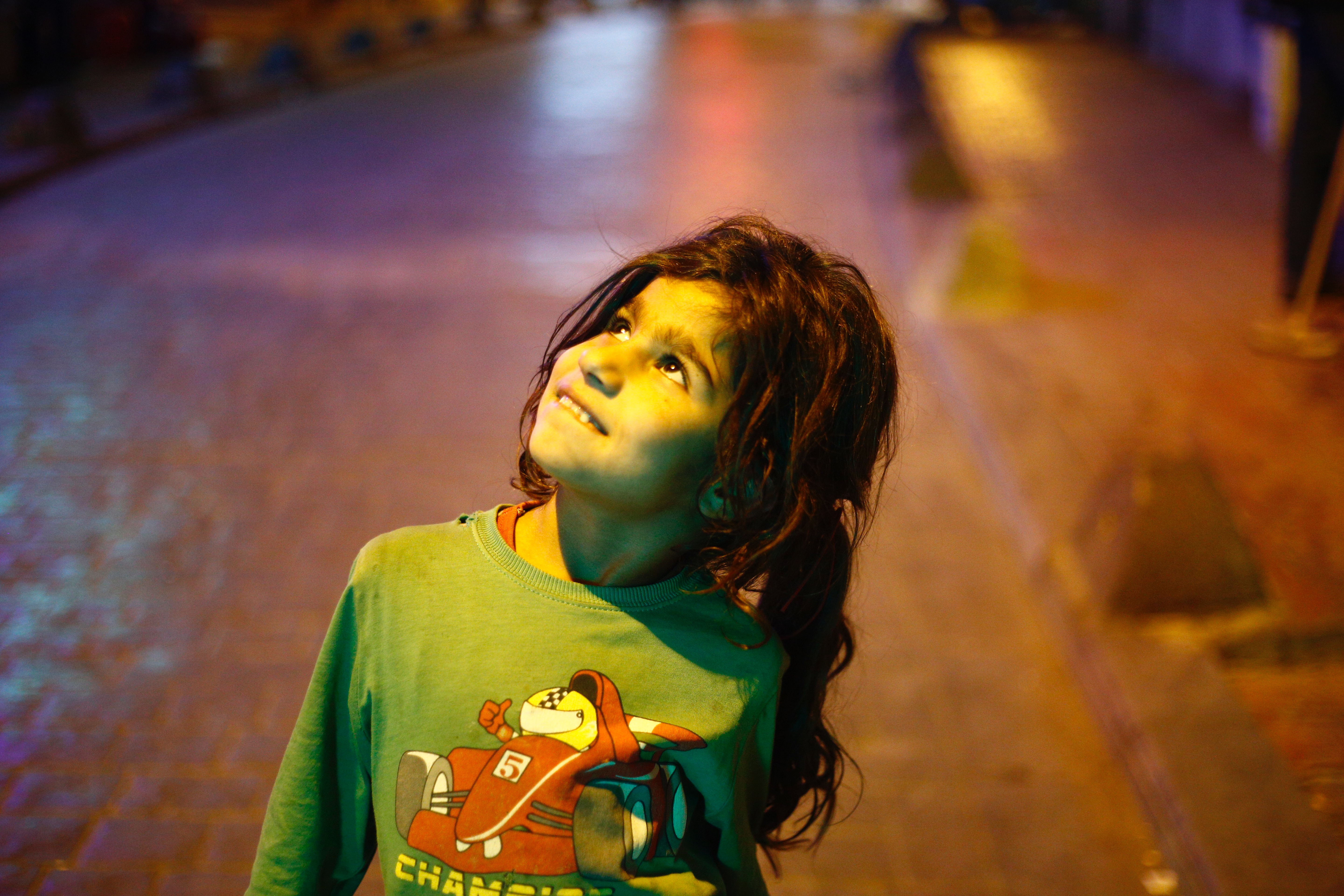|
Fundamentalism (sculpture)
''Fundamentalism'' is a monumental bronze sculpture by Jens Galschiot consisting of the letters in the word 'FUNDAMENTALISM'. The sculpture was finished in 2015 and is a part of the dialogue project The children of Abraham, also by Galschiot. Overview Each one of the 14 letters are made up of stabbed bronze books, stacked 2.5 meters high and forming a closed circle 9 meters wide. The books are put on a plinth, which is 1 meter tall. The books are stacked on each other to form individual letters, but separately so that one character is built of Korans, another of Bibles, and another of the Torah. Each book is a model of an original religious book, made in wax by hand. The books, of all sizes and forms, are stacked irregularly, so the sculpture appears with a slightly shaky expression. As there are only 14 letters and 3 religions, one religion will have only 4 letters but they will be bigger than the others. On the outside of the circle directly on the individual books are p ... [...More Info...] [...Related Items...] OR: [Wikipedia] [Google] [Baidu] |
Jens Galschiøt
Jens Galschiøt (born 4 June 1954) is a Danish sculpture, sculptor best known for the ''Pillar of Shame''. Galschiøt moved to Odense in 1973, and in 1985 he opened a combined foundry, studio, Gallery Galschiøt and sculpture park. In 1990, Galschiøt, Erik Mortensen and Jean Voigt, created the sculpture ''The Ringwearer's Jacket'', which was commissioned by the Clothing Industry's Union of Denmark for Queen Margrethe II’s 50th birthday. Galschiøt contributed work to the Seville Expo '92. Jens Galschiot is a complex artist whose work incorporates elements of installation art, conceptual art, happening, performance art, and street art, Street Art with clear references to "social sculptures" (Joseph Beuys), Symbolisme (stilperiode), Symbolism and Art Nouveau. Jens Galschiot mainly works with sculptures to fight the injustice in the world, and puts them up in big squares and cities all around the world. The sculptures are mainly made in bronze and paid for with his own money. In ... [...More Info...] [...Related Items...] OR: [Wikipedia] [Google] [Baidu] |
Wisdom
Wisdom, sapience, or sagacity is the ability to contemplate and act using knowledge, experience, understanding, common sense and insight. Wisdom is associated with attributes such as unbiased judgment, compassion, experiential self-knowledge, self-transcendence and non-attachment, and virtues such as ethics and benevolence. Wisdom has been defined in many different ways, including several distinct approaches to assess the characteristics attributed to wisdom. Definitions The ''Oxford English Dictionary'' defines wisdom as "Capacity of judging rightly in matters relating to life and conduct; soundness of judgment in the choice of means and ends; sometimes, less strictly, sound sense, esp. in practical affairs: opp. to folly;" also "Knowledge (esp. of a high or abstruse kind); enlightenment, learning, erudition." Charles Haddon Spurgeon defined wisdom as "the right use of knowledge". Robert I. Sutton and Andrew Hargadon defined the "attitude of wisdom" as "acting with knowle ... [...More Info...] [...Related Items...] OR: [Wikipedia] [Google] [Baidu] |
Survival Of The Fattest (sculpture)
''Survival of the Fattest'' is a sculpture of a small, starved boy carrying a fat woman. The sculpture was made by Jens Galschiøt and Lars Calmar in 2002, as a symbol of the imbalanced distribution of the world’s resources. In 2006 it was acquired by the city of Ringkøbing, Central Denmark Region, and placed in the harbour. Sculpture and symbols The 3.5 metre tall bronze sculpture was made in 2002 and depicts a huge fat woman from the west, sitting on the shoulders of a starved African boy. The woman is holding a pair of scales, as a symbol of justice, but her eyes are closed—a reference to the traditional depiction of Lady Justice wearing a blindfold, but also a suggestion that justice is degenerating into a self-righteous unwillingness to see an obvious injustice. The sculpture was intended to send out a message to the rich part of the world; it seems to create focus on our obesity due to over consumption while people in the third world are dying of hunger. Due to the imb ... [...More Info...] [...Related Items...] OR: [Wikipedia] [Google] [Baidu] |
Pillar Of Shame
''Pillar of Shame'' is a series of sculptures by Danish artist Jens Galschiøt memorialising the loss of life during specific events or caused by specific circumstances in history. Each sculpture is an tall statue of bronze, copper or concrete. The first sculpture was inaugurated at the NGO Forum of the FAO summit in Rome, Italy in 1996. Since then three other pillars have been erected, in Victoria City, Hong Kong, Victoria City, Hong Kong; Acteal, Mexico; and Brasilia, Brazil. A fifth in Berlin, Germany was planned for completion in 2002, but the plan has not come to fruition due to The ''Pillar of Shame'' in Berlin – a Memorial for the Victims of Nazi Terror Aidoh.dk. Retrieved on 16 November 2010. Symbolism According to Galschiøt, the sculptures remi ...[...More Info...] [...Related Items...] OR: [Wikipedia] [Google] [Baidu] |
Model 2 Of Fundamentalism Sculpture
A model is an informative representation of an object, person or system. The term originally denoted the plans of a building in late 16th-century English, and derived via French and Italian ultimately from Latin ''modulus'', a measure. Models can be divided into physical models (e.g. a model plane) and abstract models (e.g. mathematical expressions describing behavioural patterns). Abstract or conceptual models are central to philosophy of science, as almost every scientific theory effectively embeds some kind of model of the physical or human sphere. In commerce, "model" can refer to a specific design of a product as displayed in a catalogue or show room (e.g. Ford Model T), and by extension to the sold product itself. Types of models include: Physical model A physical model (most commonly referred to simply as a model but in this context distinguished from a conceptual model) is a smaller or larger physical copy of an object. The object being modelled may be small (for ... [...More Info...] [...Related Items...] OR: [Wikipedia] [Google] [Baidu] |
Copenhagen
Copenhagen ( or .; da, København ) is the capital and most populous city of Denmark, with a proper population of around 815.000 in the last quarter of 2022; and some 1.370,000 in the urban area; and the wider Copenhagen metropolitan area has 2,057,142 people. Copenhagen is on the islands of Zealand and Amager, separated from Malmö, Sweden, by the Øresund strait. The Øresund Bridge connects the two cities by rail and road. Originally a Viking fishing village established in the 10th century in the vicinity of what is now Gammel Strand, Copenhagen became the capital of Denmark in the early 15th century. Beginning in the 17th century, it consolidated its position as a regional centre of power with its institutions, defences, and armed forces. During the Renaissance the city served as the de facto capital of the Kalmar Union, being the seat of monarchy, governing the majority of the present day Nordic region in a personal union with Sweden and Norway ruled by the Danis ... [...More Info...] [...Related Items...] OR: [Wikipedia] [Google] [Baidu] |
City Hall Square, Copenhagen
City Hall Square ( da, Rådhuspladsen, ) is a public square in the centre of Copenhagen, Denmark, located in front of the Copenhagen City Hall. Its large size, central location, and affiliation with the city hall makes it a popular venue for a variety of events, celebrations and demonstrations. It is often used as a central point for measuring distances from Copenhagen. City Hall Square is located at the southwestern end of the pedestrian street Strøget which connects it to Kongens Nytorv, the other large square of the city centre, passing Gammeltorv/Nytorv and Amagertorv along the way. Opposite Strøget, Vesterbrogade extends into the Vesterbro district and later crosses the border to Frederiksberg. H. C. Andersens Boulevard, Copenhagen's most heavily congested street, and Vester Voldgade pass the square on either side of the city hall. Apart from the City Hall, notable buildings around the square include Politikens Hus, the headquarters of national daily newspaper Politik ... [...More Info...] [...Related Items...] OR: [Wikipedia] [Google] [Baidu] |
Charity (virtue)
In Christian theology, charity (Latin: ''caritas'') is considered one of the seven virtues and is understood by Thomas Aquinas as "the friendship of man for God", which "unites us to God". He holds it as "the most excellent of the virtues". Further, Aquinas holds that "the habit of charity extends not only to the love of God, but also to the love of our neighbor". The Catechism of the Catholic Church defines "charity" as "the theological virtue by which we love God above all things for His own sake, and our neighbor as ourselves for the love of God". Caritas: the altruistic love The phrase ''Deus caritas est'' from —or ''Θεὸς ἀγάπη ἐστίν'' (Theos agapē estin) in the original Greek is translated in the King James Version as: "God is love", and in the Douay-Rheims bible as: "God is charity" (). Thomas Aquinas does not simply equate charity with "love", which he holds as a passion, not a virtue. The King James Version uses both the words ''charity'' and '' ... [...More Info...] [...Related Items...] OR: [Wikipedia] [Google] [Baidu] |
Hope
Hope is an optimistic state of mind that is based on an expectation of positive outcomes with respect to events and circumstances in one's life or the world at large. As a verb, its definitions include: "expect with confidence" and "to cherish a desire with anticipation." Among its opposites are dejection, hopelessness, and despair. In psychology Professor of Psychology Barbara Fredrickson argues that hope comes into its own when crisis looms, opening us to new creative possibilities. Frederickson argues that with great need comes an unusually wide range of ideas, as well as such positive emotions as happiness and joy, courage, and empowerment, drawn from four different areas of one's self: from a cognitive, psychological, social, or physical perspective. Hopeful people are "like the little engine that could, ecausethey keep telling themselves "I think I can, I think I can". Such positive thinking bears fruit when based on a realistic sense of optimism, not on a naive "f ... [...More Info...] [...Related Items...] OR: [Wikipedia] [Google] [Baidu] |
Faith
Faith, derived from Latin ''fides'' and Old French ''feid'', is confidence or trust in a person, thing, or In the context of religion, one can define faith as "belief in God or in the doctrines or teachings of religion". Religious people often think of faith as confidence based on a perceived degree of warrant, or evidence while others who are more skeptical of religion tend to think of faith as simply belief without evidence.Russell, Bertrand"Will Religious Faith Cure Our Troubles?" ''Human Society in Ethics and Politics''. Ch 7. Pt 2. Retrieved 16 August 2009. Etymology The English word ''faith'' is thought to date from 1200 to 1250, from the Middle English ''feith'', via Anglo-French ''fed'', Old French ''feid'', ''feit'' from Latin ''fidem'', accusative of ''fidēs'' (trust), akin to ''fīdere'' (to trust). Stages of faith development James W. Fowler (1940–2015) proposes a series of stages of faith-development (or spiritual development) across the human lifespan. ... [...More Info...] [...Related Items...] OR: [Wikipedia] [Google] [Baidu] |
Compassion
Compassion motivates people to go out of their way to relieve the physical, mental or emotional pains of others and themselves. Compassion is often regarded as being sensitive to the emotional aspects of the suffering of others. When based on notions such as fairness, justice and interdependence, it may be considered rational in nature. The word "compassion" comes from Middle English, and derives from Old French, via ecclesiastical Latin compassio(n- ), from compati (‘suffer with’). Compassion involves "feeling for another" and is a precursor to empathy, the "feeling as another" capacity (as opposed to sympathy, the "feeling towards another"). In common parlance, active compassion is the desire to alleviate another's suffering. Compassion involves allowing ourselves to be moved by suffering, and experiencing the motivation to help alleviate and prevent it. An act of compassion is defined by its helpfulness. Qualities of compassion are patience and wisdom; kindness and per ... [...More Info...] [...Related Items...] OR: [Wikipedia] [Google] [Baidu] |






_2.jpg)